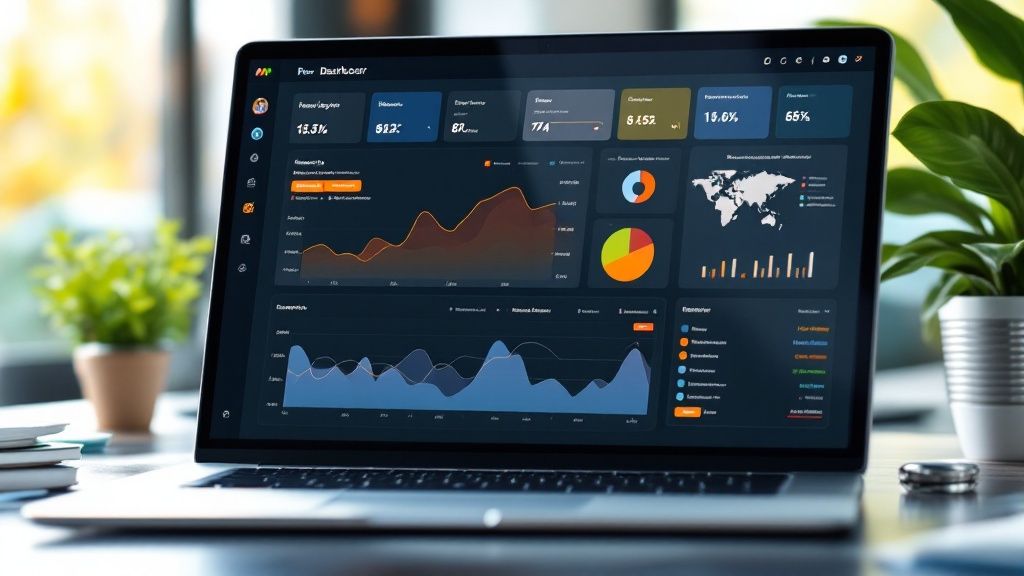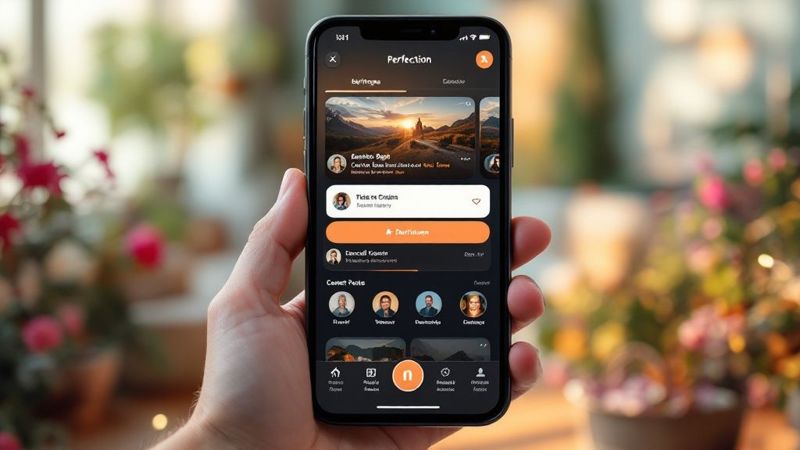Understanding Dynamic Content Beyond Basic Personalization

When most people think of personalized content, they imagine simple name fields in an email. But dynamic content goes far deeper - it's content that actively adapts based on who's viewing it, when they're viewing it, and what actions they've taken before.
Real-World Examples of Dynamic Content in Action
Think about shopping online - have you noticed how product recommendations seem to match your interests? That's dynamic content in action. The same website can show completely different products to different visitors based on their browsing history and preferences.
Location plays a big role too. A retail chain's website might show your nearest store locations, local deals, and even adjust language settings based on where you are. For instance, Covera, an online shopping site, tested this approach and saw amazing results - 117.86% more sales in one product category after adding personalized welcome messages and smart exit offers. Their overall conversion rate jumped by 60.4%. Want to dig deeper? Learn more about dynamic content here.
You might also enjoy: What Is Personalized Content and Why Is It Important?
Key Factors Driving Dynamic Content
Three main elements power truly effective dynamic content:
- User Behavior Data: Every click, page view, and purchase helps build a picture of what each visitor cares about
- Context Awareness: Understanding where users are, what device they're using, and when they're active helps deliver more relevant content
- Adaptive Technologies: Smart systems that can automatically adjust content using clear rules or AI help make real-time personalization possible
These pieces work together like instruments in an orchestra - each plays its part in creating an experience that feels natural and personal. When done right, dynamic content doesn't feel forced or robotic - it simply makes the user's experience smoother and more relevant.
Mastering E-commerce Personalization: The Amazon Blueprint

Amazon has set the standard for personalized online shopping by focusing on what matters most - understanding and meeting individual customer needs. Their approach goes beyond basic product listings to create unique experiences for every shopper. Let's explore how Amazon makes this magic happen and see how other businesses can apply these proven methods.
The Power of Product Recommendations
At the heart of Amazon's success is their smart product suggestion system. This engine looks at what customers browse, buy, and consider to make relevant recommendations. For example, if you buy running shoes, you'll likely see suggestions for workout clothes, fitness watches, or similar gear that other runners often purchase. These personalized suggestions work incredibly well - generating approximately 35% of Amazon's total sales revenue. Learn more about the impact of personalized recommendations.
Dynamic Pricing and Inventory Updates
Smart pricing and stock tracking help create a smooth shopping experience. Prices adjust based on multiple factors like market demand and competition. At the same time, the system constantly updates product availability to prevent customers from trying to buy out-of-stock items. These real-time updates keep shoppers informed and help businesses maximize their sales potential.
Personalized Promotions and Offers
Custom deals make shoppers feel valued and understood. New customers might see welcome discounts, while regular buyers get offers based on their interests and purchase history. A customer who frequently looks at kitchen gadgets, for instance, might receive a special deal on cooking tools. These targeted promotions help turn browsers into buyers and keep customers coming back.
Balancing Personalization and Privacy
Getting personalization right means respecting customer privacy. The best online stores are open about how they collect and use customer data, giving shoppers control over their information. Clear privacy policies and easy-to-use data settings help build trust. When customers feel their privacy is protected, they're more likely to embrace personalized shopping experiences that make their lives easier.
Real-Time Content Solutions That Drive Engagement

Real-time content delivers information that's both relevant and immediate to users as they interact with your site. When content updates instantly based on user actions and preferences, it creates an engaging experience that keeps visitors actively involved. Think of a sports website where scores and stats update automatically during a game - this kind of immediate feedback naturally draws users in and encourages them to stay longer.
Examples of Real-Time Dynamic Content in Action
Here's how different industries are putting real-time content to work:
- E-commerce: Online stores show exact inventory numbers that update as products sell. When shoppers see "Only 3 items left!" they're more likely to make a quick purchase decision.
- Travel: Flight booking sites display current prices and seat availability that change by the minute. This helps travelers book confidently knowing they have the latest information.
- Customer Service: Live chat tools let support agents respond instantly to questions. Quick back-and-forth communication leads to faster problem solving and happier customers.
These real-time features rely on APIs to pull in fresh data continuously. For example, a hotel booking platform connects to multiple databases to show up-to-the-minute room availability. The system can also personalize content based on the user's location - showing nearby hotels first or adjusting prices to the local currency. Even small touches like addressing users by name in chat messages help create a more personal experience. Learn more about dynamic content examples.
Technical Considerations for Real-Time Content
Making real-time content work smoothly requires careful planning:
- Data Processing: Your systems need to handle constant data updates without slowing down
- Performance: The infrastructure must stay responsive even during traffic spikes
- System Integration: Real-time features should work naturally with your existing website
Getting these technical elements right ensures users have a smooth experience.
Measuring the Impact of Real-Time Content
Track these key metrics to see how real-time content affects your business:
- Conversion Tracking: Monitor how instant updates influence buying decisions
- User Engagement: Look at time spent on site and interaction patterns
- User Feedback: Pay attention to customer reviews and satisfaction scores
Regular measurement helps you fine-tune your approach and shows whether your real-time content strategy is delivering results. Use this data to make smart improvements that keep your site engaging and effective.
Taking Email Marketing to New Heights with Dynamic Content

While email marketing remains essential for businesses, standard mass emails often fall flat. The solution lies in dynamic content - a powerful approach that replaces generic messaging with personalized experiences tailored to each recipient's needs and interests.
Beyond Name Tags: Creating Truly Personal Email Experiences
Dynamic email content does much more than just insert a recipient's name. It shapes the entire email experience around individual preferences and actions. For instance, an e-commerce company can display products based on what customers have viewed or purchased before. This level of personal relevance makes subscribers much more likely to engage and convert.
Smart Audience Groups: Sending the Right Message
The foundation of effective dynamic emails is smart segmentation. By grouping subscribers based on specific traits like demographics, purchase patterns, and website behavior, you can craft messages that speak directly to their interests. Someone who left items in their cart will see different content than a frequent buyer. This targeted approach ensures every email feels relevant and valuable.
You might be interested in: The Power of Dynamic Email Images: Boosting Your Email Marketing Strategy
Perfect Timing: Delivering Emails When They Matter Most
When you send emails matters just as much as what you send. By analyzing when each subscriber tends to open and engage with emails, you can schedule delivery during their most active times. This simple adjustment can lead to better open and click rates since your messages arrive when recipients are most likely to see them.
Fine-Tuning Your Approach: Testing and Improving
Dynamic content lets you run A/B tests on different email elements. You can try various subject lines, calls-to-action, and layouts to see what works best for different audience segments. Track key metrics like opens, clicks, and conversions to understand what's connecting with readers. Regular testing and refinement helps you create emails that don't just feel personal - they deliver real results that grow your business.
Making Social Media Content Work Harder With Personalization
Social media success comes down to making real connections with your audience. By using data intelligently and creating personalized content, brands can build meaningful engagement that stands out. Let's explore proven ways to make your social media content more relevant and impactful.
Using Data to Know Your Audience Better
The foundation of effective personalized content is understanding your audience through data. Social media platforms provide detailed analytics about who your followers are, what they care about, and how they behave. You can use these insights to segment your audience and craft messages that resonate with different groups. For instance, you might create different ad variations based on past purchases or how people have interacted with your brand before.
Making Social Media Feel More Personal
Think about seeing an ad for something you were just looking at online - that's personalized content in action. Facebook's dynamic product ads automatically show relevant items based on browsing history, leading to better engagement. Similarly, you can use retargeting on platforms like Twitter to reconnect with people who've shown interest in your brand, perhaps reminding them about items they viewed or left in their cart.
Getting Creative with Interactive Elements
Personalization goes beyond basic text and images. Interactive content like polls, quizzes and surveys helps you learn about your audience while creating an engaging experience. For example, a travel company could use a quiz to understand vacation preferences, then show personalized destination recommendations. Video content can also adapt its storyline or calls-to-action based on viewer data, making each person's experience unique.
Real Examples of Personalization Done Right
Here are some ways brands are successfully personalizing their social media:
- Smart video ads: Different video content shown to different audience segments
- Local targeting: Special offers customized by location
- Interactive stories: Using polls and quizzes to create two-way conversations
These examples show how personalizing content helps brands build stronger connections with their audience. When you make social media more relevant to each person, you create better experiences that drive real business results.
Measuring and Optimizing Dynamic Content Performance
Analyzing how well your dynamic content performs is essential for getting real results. Like tending a garden, you need to regularly check on your content and make adjustments based on what you observe. The key is knowing which numbers matter most and having the right tools to track them.
Key Metrics for Evaluating Dynamic Content Success
Different goals require different measurements. If you run an e-commerce site, you'll want to focus on conversion rates and average order values. For content marketing, metrics like time spent reading and social shares tell a better story. Here are the main numbers to watch:
- Conversion Rate: Shows how many visitors take your desired action, like making a purchase. Higher rates mean your content connects with readers
- Engagement Rate: Reveals how much visitors interact through shares, comments and other actions. More engagement suggests your content resonates
- Click-Through Rate (CTR): Tells you when visitors click links or calls-to-action to learn more
- Bounce Rate: Indicates if visitors leave quickly, which may mean the content isn't what they expected
- Time on Page: Longer visits usually show that people find your content valuable and engaging
Tools and Technologies for Accurate Tracking
Several tools can help you gather and understand how your dynamic content performs:
- Google Analytics: Provides core data about visitor behavior, including page views and conversions
- A/B Testing Software: Lets you test different content versions to find what works best
- Marketing Automation: Often includes built-in tracking for emails and campaigns
- Heatmap Tools: Show exactly how visitors interact with your pages through visual reports
Frameworks for Continuous Optimization
Like steering a ship, dynamic content needs constant adjustment. Follow this structured approach:
- Set clear goals: Know exactly what you want your content to achieve
- Check the numbers regularly: Review your key metrics to spot what needs improvement
- Try new versions: Test different content approaches and targeting rules
- Make data-backed changes: Use what you learn to improve your strategy
- Keep the cycle going: Continue monitoring and adjusting for better results
Smart companies use real data to guide their decisions. By watching how visitors interact with their content, these businesses can better target their message and improve results over time. For more insights, check out: How to Use Customer Data to Drive Email Marketing Success.
Want to make your image personalization easier? OKZest automatically creates personalized images that work seamlessly with your email and website platforms. From targeted email campaigns to customized web experiences, OKZest helps you connect with each visitor individually. Try it free today to see the difference.